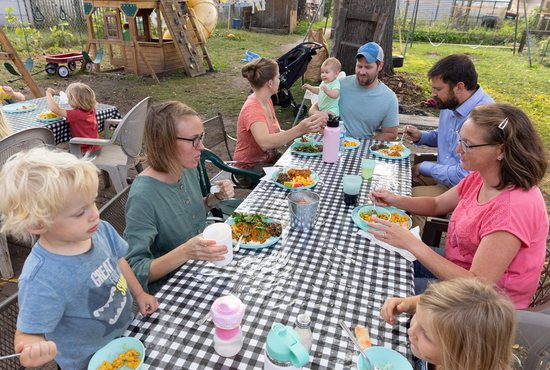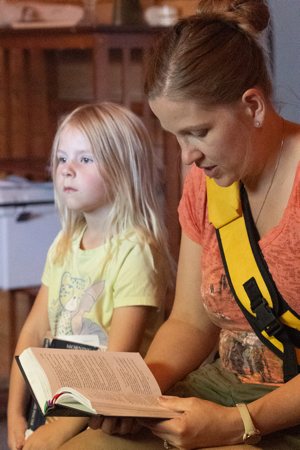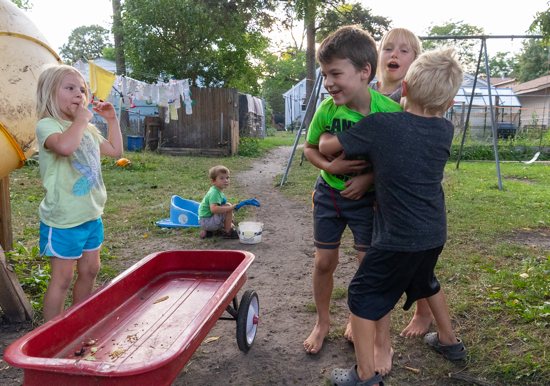
Dinner guests at the Maurin House, a relatively new Catholic Worker community in Columbia Heights, might be tempted to describe what they see as an exceptional and lofty expression of Christian life.
Just don’t expect the two families that make up the community to necessarily agree with you.
“We really don’t think that what we’re doing is something that any ordinary Catholic couldn’t do, either,” explained Tyler Hambley, 37, who with his wife, Crystal, 38, longtime friends Colin and Leigh Miller (44 and 35), and each couple’s four children make up the Maurin House community.
The way the Hambleys and Millers live their lives, however, bucks the standard American ideal: They’ve prioritized intentional community — to the point that the Hambleys moved across the country for the sake of living next door to their close friends. They’ve converted a garage into a chapel and gather there for daily communal prayer. They open their home for an “all are welcome” style dinner two days a week. And they acquired a third house where the poor and the homeless are invited to live, joining them in community.

This might strike many Catholics as an “extraordinary” way of life, a response to a “special call” to go above and beyond normal Christian practice, but that’s not how the Hambleys and the Millers see it. They say they’re just following the Gospel and the Catholic faith, plain and simple.
“It might not look exactly the same as what we’ve done, but building Catholic community, offering hospitality and being present with others, especially the poor, over a shared dish is something all Catholics can do,” he said.
In fact, the Maurin House community is guided by the conviction that these sorts of things aren’t optional aspects of following Christ — they’re integral to it.
The Beatitudes and the Sermon on the Mount; the evangelical counsels of poverty, chastity and obedience; and the spiritual and corporal works of mercy are some of the primary touchpoints of Christ’s teaching and the Church’s traditional practice that animate the Maurin House community and its commitments to prayer, simplicity, life in common and hospitality to the poor.
And unsurprisingly so, given that these sources are also at the heart of the Catholic Worker movement, a major source of inspiration for the Hambleys and Millers for more than a decade.
The Maurin House is named for Peter Maurin, who co-founded the Catholic Worker movement with Servant of God Dorothy Day in 1933 in an effort to help others “live in accordance with the justice and charity of Jesus Christ” in the modern world. The French Catholic theologian, poet and social activist was adamant that poverty, chastity and obedience “are for everybody, not only for the monks.” Maurin was also a major advocate and articulator of “the gentle personalism of traditional Catholicism.” This, he explained in an essay on the beliefs of the Catholic Worker, entails “the personal obligation of looking after the needs of our brothers and sisters.”
This kind of “personalism,” explained Colin Miller, gives the Catholic Worker a distinctive way of understanding the relationship between Catholic social teaching and personal discipleship.
“They’re of one piece,” Miller said. “The Catholic Worker approach is that you don’t get to throw out the Sermon on the Mount and its claim on you personally when you’re thinking about its social implications.”
For example, the Catholic social teaching principle of subsidiarity underscores that “a community of a higher order should not interfere in the internal life of a community of a lower order, depriving the latter of its functions,” according to the Catechism. For the Maurin House, the principle isn’t just a guide for how to think about macro-level policies and the “size of government,” it’s also a teaching that applies directly to their lives and their response to Christ’s command to care for “the least of these” — the poor.
“Christians are called to take personal responsibility for those who are in front of us,” Miller said. “If you can take care of this homeless person who is right in front of you, don’t send them to the shelter. Don’t go up one level without having to.”
The Catholic Worker approach also emphasizes that “prayer and work are one and the same thing,” Hambley said. “Our prayers are not just words, but speech-acts that can only be rendered true against the background of a form of life that makes sense of them.”
In other words, the prayers of the Church are intrinsically connected with living them out. For instance, Hambley points to Psalm 9:18, which the community recites in their Morning Prayer, that says, “May the hope of the poor not be taken away.”
“What kind of life do I have to live to render that speech true?” he asked rhetorically, adding that “prayer doesn’t stop at the ‘amen’ — that’s the green light to go and do.”

A ‘radical’ recovery
If the Maurin House’s approach to community life or hospitality to the poor strike others as “extraordinary,” the Millers and Hambleys suggest it might have less to do with their actions, and more to do with how far what presently passes for “ordinary” has moved from traditional Catholic practice.
At the heart of this shift, Maurin House members say, is modern society’s hellbent quest for individual autonomy and self-determination, which produces fragmentation and isolation.
“We love technology, politics, scientific institutions and insurance, because they advance our quest to be as independent as possible,” reads a document articulating the Maurin House’s convictions. “So, pretty soon, after a million cultural changes with this intention, it’s no surprise that we don’t need other people anymore. I wanted a life I could do by myself, and I got it.”
The result is that the individual is divorced from the community, man is cut off from nature, and the Church is isolated from the material and the social. Catholics are shaped by these forces, too, and can all too easily embrace isolating practices and systems for the sake of convenience and security. On this account, Christianity is reduced to a one-on-one relationship with Jesus or individualistic moralism, and social responsibility, such as the call to take personal responsibility for the poor, is outsourced to the government or to “professionalized” charities.
As an illustration of this shift, Leigh Miller pointed to Sigrid Undset’s Nobel Prize-winning 1928 trilogy “Kristin Lavransdatter,” which is seeing a popular resurgence and is celebrated in part for its accurate and compelling depiction of life in 14th century (and still Catholic) Norway. The narrative, Miller said, is defined by “the constant presence of the poor” and a corresponding eagerness to serve them and others in need.
In contrast, “what we have today, in this country, is an ability to not be around the poor unless one chooses to,” she said. “So, if you want to house the poor and feed the hungry, then you have to show some real intentionality in order to do it.”
The Maurin House members’ way of life also includes voluntary poverty and a kind of mutual dependence upon each other and the generosity of others. They see this as an attempt to break free from the fragmentation of modern society and return to a more communitarian and Catholic mode of living, re-integrating what modernity pulls apart. In their view, there might be no other way to fruitfully live the Catholic life today.
“We simply must find new ways of embedding the Gospel in, or rather, of allowing the Gospel to be, the social fabric, of real local communities, or face the real possibility of not being able to practice the Faith at all,” reads the Maurin House’s guiding document’s description of what Pennsylvania-based Catholic Worker and theologian Larry Chapp has described as “the Maurin Mandate.”
The Maurin House’s document makes clear that the Catholic Worker movement is not the only way of living this conviction out, but it’s also adamant that “the Gospel being what it is, and our society being what it is, intentional Catholic living will tend to take similar forms: liturgy, lay leadership, small community, local living, hospitality, simplicity, friendship with the poor, and a critical, Catholic analysis of our culture.”
Similar to Dorothy Day’s famous resistance to being called a saint because she didn’t “want to be dismissed that easily,” the sense that this call applies to all Catholics in the modern world makes Maurin House members resistant to being heralded as some kind of special ascetical celebrities.
“The point is, once you’re placed on some unreachable pedestal, or even just of thought of as having some idiosyncratic charism or mission, then (one’s actions can be dismissed as), well, ‘What’s good for you is good for you, and what’s good for me is good for me,’” Hambley said.
Instead, they want to encourage others to think of a more communitarian life as the norm. This form of living has strong precedents in Catholic tradition, from the early Church community described in Acts that shared everything in common to Franciscan third-order lay communities. It’s a “philosophy so old that it looks like new,” reads a tagline on the Maurin House website, another phrase from Peter Maurin’s essays.
The same spirit informs “The Catholic Radical,” a “Catholic newspaper for a divided age” spearheaded by the Maurin House community. “Radical” doesn’t mean “contrarian,” Colin Miller explained. Instead, it means getting to the root of something.
“What we want to do is cling to the roots of the Church and the Gospel and see what difference that makes in our lives,” he said. “We don’t have any desire to be against the flow of the world except insofar as the roots of the Gospel position us against the flow of the world.”
And when the roots of the Gospel do in fact position Christians against the contemporary status quo, “It’s just a matter of being willing to look foolish, because the Gospel is foolishness to the world,” Miller said.
“You’re going to get blank stares from people and people who laugh at you and say, ‘That’s stupid’ and ‘They’re just young and idealistic,’” he said. “Well, so far, I’ve managed to stay young and idealistic for 12 years or so.”
Organic development
If the Hambleys and the Millers sound convinced, it’s because their lives have been marked by both the joys of living in thick, intentional community and the anguish experienced when living without it.
They first experienced this kind of community in Durham, North Carolina, over a decade ago, where they’d come for graduate studies at Duke University — and when they weren’t yet Catholic. As Miller explains, friendships that formed with people living on the street soon led to offering spare rooms to their homeless friends or renting out apartments for them. Miller described this as a “mom-and-pop” iteration of Catholic Worker-style hospitality houses.
Convicted by the fruitfulness of this way of life and desiring to commit to it more deeply, Miller said they went to the one place where graduate students naturally go when they have a question: the library. There, after searching for ways that Christians had lived with the homeless, they discovered the lives and writing of Dorothy Day (1897-1980) and Peter Maurin (1877-1949). They provided what Miller described as “by far the most compelling vision of interacting with the poor and homeless that I had come across.”
In 2012, the first Maurin House was established, described by Miller as an “Episcopal Catholic Worker house.” But Maurin and Day’s witness didn’t stop with providing a model for how to live with the poor.
“The long and short of it is we converted to Catholicism largely under the influence of Dorothy and Peter’s Catholicism,” said Miller, who became Catholic in June 2016; his wife became Catholic that December, and the Hambleys entered the Church in 2017. “You realize that (Day and Maurin’s) hospitality and the Catholic Worker is only intelligible as an outflowing of their Catholicism.”
The Millers lived in the Durham community for three years before moving to Pennsylvania so Colin, who had graduated with a doctorate in theology, could teach. They soon realized just how important the thick community they’d experienced in North Carolina really was.
When living in Durham, Miller recalled, “We’d always say, ‘Oh man, it must be so hard to live an authentically Christian life out there in the world, given all these dynamics we see in play.’ And then each of us left and went our separate ways and tried to live it out there and we were like, ‘Oh shoot, we were right. It’s really bad out here, and lonely.’”
Their experience of isolation prompted the Millers to move to Colin’s home state of Minnesota in 2018. The Hambleys, meanwhile, were experiencing something similar after moving back to Kansas to live near family.
“All that we once depended on in terms of community life was lost, and the only way we could start to get that back was to reach out to some old friends,” Hambley said. He described the move to Minnesota in 2020 as a decision to reject the “life of decision,” or constant choice.
“In other words, we knew we needed to ground ourselves in those regular patterns of habits and practices a faithful Catholic form of life must take in the modern world if it’s going to survive. You can’t do that by yourself,” Hambley said.
By the grace of God, the Hambleys were able to purchase the house with an adjoining backyard to the Millers’ home. The two families tore down the fence between them, and set up their garage chapel, knowing that prayer together would be the basis of their communal life.
And from that common life in Christ and the conversations that surrounded it developed the various acts that define life at the Maurin House today, said Miller.
“We just started inviting people to come together and join us, and then very quickly after that, we’re like, ‘Well, we’ve got to have the poor, too,’ because that authenticates, in a particular way, Christian community,” avoiding the trap of “bourgeois Catholicism” that is still ultimately guided by choice and taste.
In addition to praying Evening Prayer together every day as a community, the Maurin House hosts 5:30 p.m. dinners every Monday and Friday. They’re not especially formal, but rather more “come as you are” style affairs, set in the backyard (at least when the weather permits) amid the chickens and the children. Their dinners are open to everyone and on any given night may include a local priest, a University of St. Thomas professor and his family, a curious med school student or one of the guests staying in the hospitality house.
The hospitality house was set up in October 2021 after the Maurin House community acquired a third home across the street, allowing them to convert the house in between the other two into a place of gathering and hospitality for the poor. At any given time, three or four previously homeless men live in the house of hospitality, where they’re invited to be part of the community.
“It’s been an accidental community,” Miller explained. “We didn’t set out from the beginning to say we’re going to have a hospitality house here in Minnesota. We just started living with our friends and praying together.”
Fruitful living
The Maurin House’s members are adamant that they are not living some kind of perfect Christian life. Sin and weakness still affect them, and the fragmenting forces of modern life still have a powerful pull. Furthermore, members insist that their efforts at hospitality and caring for the poor are small, meager and mixed with as many failures as successes.
“We’re not really doing all that much,” Leigh Miller said.
Leigh also acknowledged that communal life “can be really challenging, and it is really challenging. But there’s a depth to it that is really beautiful and good.”
Colin said he’s motivated by the fruitfulness they’ve found by committing themselves to other Christians and “rubbing up against them daily, in a way that causes inconvenience on a regular basis and makes you dependent.”
“That brings me a great amount of joy,” he said. “Because we’re meant to be bound up, both spiritually and materially, with our fellow man.”
Hambley described living in intentional community as a revealing experience, in which one’s faults and conceits are exposed to others, and vice versa. Uncomfortable as this experience might be, “it is also extraordinarily freeing to relinquish the tyranny of self. At that point, you can let your hair down and just have fun.”
And while acknowledging that the experience of relinquishing control and security and depending more fully on God can be “terrifying,” Hambley said it can help one to more fully embrace and depend upon God’s baptismal promise of overcoming even death, providing freedom from fear and anxiety that come with grasping for security.
“Go on an adventure instead,” he said.



